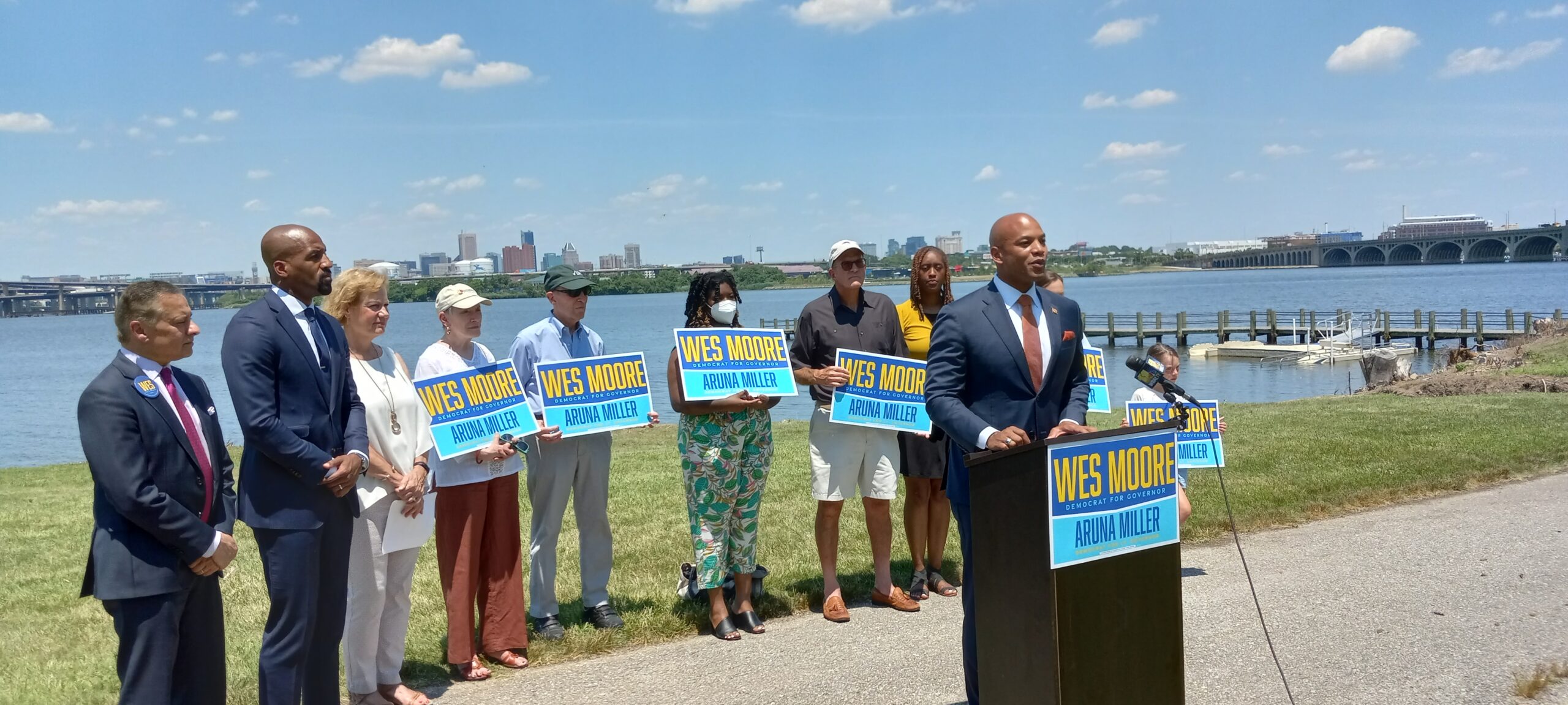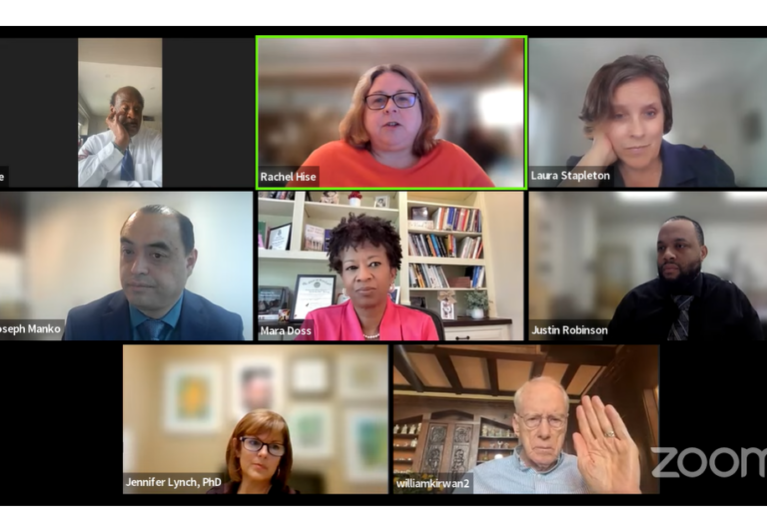Md. Candidates Fret, Tout Green Credentials as Supreme Court Ties EPA’s Hands on Emissions

Just hours after the U.S. Supreme Court ruled Thursday that the U.S. Environmental Protection Agency lacks authority to broadly regulate greenhouse gas emissions, Democratic gubernatorial candidate Wes Moore stood on the banks of the Patapsco River in Baltimore, surrounded by environmental leaders, promising to take swift and bold action on climate change if elected.
The justices, Moore said, “decided to back those who are violating our environmental protections, and I’m here to say that the state of Maryland is going to push back.”
Moore’s news conference at Middle Branch Park, to spotlight the climate priorities he’d pursue in his first 100 days in office, had been in the works for several days. But there was always the possibility that it would coincide with the ruling in West Virginia v. EPA, Republican states’ and coal companies’ challenge to the agency’s authority to do more than just narrowly regulate the emissions of individual power plants.
So while Moore had the most coordinated and stage-crafted statements condemning the Supreme Court decision, he was hardly the only gubernatorial aspirant or environmentalist in Maryland expressing outrage over it.
Moore was accompanied by Kim Coble, executive director of the League of Conservation Voters, which recently bestowed a valuable endorsement on the candidate, and three environmentally minded lawmakers who are also backing him: House Environment and Transportation Committee Chair Kumar Barve (D-Montgomery); Del. Stephanie Smith (D-Baltimore City), who in her day job is a top official at the Baltimore City Department of Planning; and Baltimore City Councilmember Mark Conway (D), who has worked at the EPA and at the Chesapeake Conservancy — and is a climate hero to Moore.
“This election cycle could not be more important,” Coble said. “Given the decision out of the Supreme Court today, I can’t emphasize enough the importance of this election.”
Coble noted that the next governor will implement the Climate Solutions Now Act, the sweeping legislation that Barve helped craft, which is becoming law this summer.
“We won’t succeed in implementing that bill without a courageous and committed leader,” she said. “We know he will bring the Climate Solutions Now Act to fruition.”
Moore vowed to hire a chief sustainability, mitigation and resiliency officer for state government, who will report directly to him and who will help shape and coordinate the state’s response to the climate catastrophe. He said he would rely on advice from veteran lawmakers like Barve on how to vet personnel for key environmental positions in his administration, help set aggressive goals, and work with the General Assembly to pass meaningful legislation.
“It’s a beautiful day in Baltimore,” Barve said, gesturing to the sky. “It’s a beautiful day to be in Baltimore to be for Wes Moore. We have to keep in mind that in that blue sky is too much carbon and too many micropollutants that are largely in the lungs of our constituents.”
Moore said he would also set policies and build a workforce to reach 100% clean energy use by 2035 and net zero carbon emissions by 2045, convert the state fleet to 100% electric vehicles by the time he leaves office, and prioritize environmental justice funding, among other measures.
“It’s imperative that we’re able to move boldly, to move aggressively, and to move thoughtfully into these first 100 days,” he said.
Other gubernatorial candidates also used the Supreme Court decision to promote their environmental credentials and policies — and to criticize the conservative majority on the court.
“Today’s Supreme Court decision to limit the EPA’s authority to regulate carbon emissions from power plants will only make it more difficult to combat climate change,” said Comptroller Peter Franchot (D). “This decision is disappointing, dangerous, and short-sighted.”
Former Democratic National Committee Chair Tom Perez said that “[w]ith decision after decision, this radicalized Supreme Court continues to forfeit legitimacy. States are quickly becoming our last line of defense to protect our rights — and now our planet. As governor, I’ll ensure Maryland is a national leader.”
Former U.S. Education Secretary John King also blasted the Supreme Court, but in addition his campaign suggested that his Democratic primary opponents “have disappointing records that show environmental action is simply not a priority for them.”
The King campaign called Perez’s record on climate “weak,” and said the DNC removed the ban on fossil fuel subsidies from the party platform. Moore’s proposal, King’s campaign said, “is too little too late, with an uninspired plan to reach net zero by 2045 that was already the target created by the legislature.”
And Franchot, King’s campaign said, “has long been an anti-climate voice in the state, supporting environmentally unfriendly gas pipeline projects, ‘clean coal,’ and the [Interstate] 270 toll road highway expansion project.”
What the court ruling does
The opinion was a victory for the Republican-led states that undertook the challenge, led by Maryland’s neighbor, West Virginia, and curbs President Biden’s ability to pursue his climate goals.
In the 6-3 decision, the court’s conservatives ruled that Congress only empowered the EPA to narrowly regulate the emissions of individual power plants, and the EPA could not require a sweeping industry-wide shift from coal and gas power to renewable sources.
A 2015 Obama administration rule — which never went into effect — exceeded the agency’s authority, Chief Justice John Roberts wrote for the majority.
The agency used a little known provision of the Clean Air Act, known as Section 111, to “discover” the power to broadly regulate coal- and gas-fired power plants, Roberts wrote.
“The Agency’s discovery allowed it to adopt a regulatory program that Congress had conspicuously and repeatedly declined to enact itself,” he said.
In a dissent written by Justice Elena Kagan, the court’s three liberals said the decision strips the executive branch agency charged with environmental regulation of its power to respond to the most urgent environmental issue the world faces. Executive branch agencies can use broad authorizing language to address significant issues, the liberals said.
The majority’s decision rested on the sole claim that the EPA’s requiring a shift from coal and gas power to renewable sources of energy was too large a policy change to be authorized by general language in the law, Kagan wrote.
“But that is wrong,” she wrote. “A key reason Congress makes broad delegations like Section 111 is so an agency can respond, appropriately and commensurately, to new and big problems.”
Congress delegates the power to expert agencies to address issues as they arise, which is what Congress did in the broad provision of the Clean Air Act the EPA used to establish the Clean Power Plan, she said.
“The majority today overrides that legislative choice,” the dissent reads. “In so doing, it deprives EPA of the power needed — and the power granted — to curb the emission of greenhouse gases.”
In a statement, Biden slammed the decision and said he directed his legal team to work with the Justice Department and other agencies to find other ways to reduce climate change.
The ruling was “another devastating decision that aims to take our country backwards,” he said.
But the ruling threatens Biden’s goal, codified in an executive order in December 2021, to reach a zero-carbon electricity sector by 2035, Emily Schilling, a lawyer who heads Holland & Hart’s environmental resources practice group and represented power producers who challenged the rule, said Thursday.
“This rule is a big part of Biden’s drive towards clean energy by 2035,” Schilling said. “Now they are going to get substantially fewer reductions from this type of rulemaking than they had planned.”
The EPA can still regulate greenhouse gas emissions after the ruling, but only by setting standards that are realistic for specific producers to meet without shifting how they generate power — not by mandating an industry-wide shift in generation, Schilling said.
The court majority ruled Thursday that requiring a shift in generation violates the major questions doctrine, a legal theory at the center of the case that Congress must clearly authorize an executive agency to decide an issue of major national political or economic significance.
The court’s finding has major implications across the executive branch, particularly for climate-related action.
“It does hamstring the whole administration in terms of the toolbox that it might have by broadly interpreting various federal statutes that give it authority to address climate change,” Schiller said in an interview.
While the decision guts federal authority to require a shift in power sources, state leaders with the U.S. Climate Alliance, a coalition of 21 Democratic and three Republican governors, including Gov. Lawrence J. Hogan Jr. (R) of Maryland, said they would continue to pursue aggressive emissions standards.
Editor’s note: The story has been updated to correct the name of attorney Emily Schilling.





 Creative Commons Attribution
Creative Commons Attribution